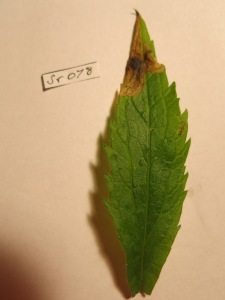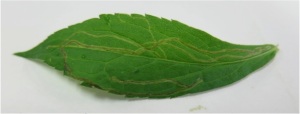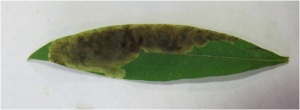I mentioned a couple of posts ago that I started studying a new system – Leaf miners of the Aster plant family. I have been very busy (apologies for not posting anything earlier). So far it’s been an amazing experience and I feel like am becoming a well-rounded scientist and biologist. Since July, I have been focusing on learning about leaf miners by spending a lot of time in the field. I was observing and collecting leaves – I was doing Natural History of Leaf miners on Goldenrods and their relatives.
The System
What are leaf miners you may ask? There’s a group of insects that feed on plant cells within the leaf. I find leaf miners an amazing group to work on. Mostly because this system (leaf miners on Asters) has a very large diversity of leaf miners: flies, beetles and moths, creating neat mines in the leaves (Figs 1-4).
This first image is a blotch mine of one of the beetle species.
This second image is a very linear mine of an Ophiomyia sp. agromyzid fly leaf miner linear mine.
This third image is of a Nemorimyza posticata agromyd fly leaf miner blotch mine
This last image is of a Calycomyza sp. agromyzid fly leaf small blotch mine.
See the huge diversity of mines! not only do the mines look different, but they also pupate (change from larva into adult) in different places depending on the species of leaf miner; some pupate in the leaf whereas others leave the leaf and pupate in the ground!
Some cool Natural History
Because I spent a lot of time watching leaf miners developing in their leaves, I was compelled to film them feeding. These following two videos are of just that; leaf miner larva feeding of Solidago (goldenrod) leaves. These videos are in real-time; you can actually see the species differences in the speed of scrapping the cells between the two leaf layers. The darker area that looks like it’s vibrating are the “mouthparts” but you can see the entire larva there. At the time of filming both were close to pupation, and they both pupated. They were filmed with my handheld Canon G15 camera through the eyepiece of a Leica M6 microscope.
The first is of Nemorimyza posticata, a large agromyzid with a broad host range, meaning it can feed on many different hosts. Once it is ready to pupate, it crawls out of the leaf and pupates in the soil. In the video, I poke it at one point with my pencil to show so that you get a sense of its size. I collected this species off of every plant I collected this summer.
The second is of Phytomyza sp., a smaller agromyzid fly. In this one I zoom out, to show the entire mine, but maybe my filming set up unstable so the film becomes a little wobbly at one point. It is believed that it also has a broad host range. although I found this species on fewer than half of the plant species I looked at.
I hope you enjoy the videos as much as I do.




